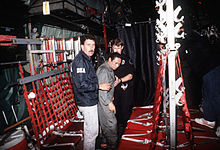Operation Nifty Package
| Operation Nifty Package | |||||||
|---|---|---|---|---|---|---|---|
| Part of the United States invasion of Panama | |||||||
 Noriega is escorted onto a U.S. Air Force aircraft by agents from the U.S. Drug Enforcement Administration (DEA) |
|||||||
|
|||||||
| Belligerents | |||||||
|
|
|
||||||
| Commanders and leaders | |||||||
| Cdr Tom McGrath Cdr Norman J. Carley |
Manuel Noriega |
||||||
| Strength | |||||||
| 52 US Navy SEAL Operators | Unknown ground forces 1 gunboat |
||||||
| Casualties and losses | |||||||
| 4 killed 8 wounded |
Unknown ground forces 1 jet destroyed 1 gunboat sunk |
||||||
Operation Nifty Package was a United States Delta and Navy SEAL-operated plan conducted in 1989 designed to capture Panamanian leader Manuel Noriega. When Noriega took refuge in the Apostolic Nunciature of the Holy See (diplomatic quarter), deafening music and other psychological warfare tactics were used to convince him to exit and surrender himself.
The United States claimed that after ten days of psychological harassment, the Papal Nuncio (ambassador) Monsignor Laboa had threatened to revoke Noriega's sanctuary if he didn't surrender to the United States, although Laboa insisted that he had made no threats of revoking the right of asylum under the Church, but had used his own "precisely calibrated psychological campaign" to force Noriega's departure.
Although the operation was successful, National Security Advisor Brent Scowcroft would later point to the psychological harassment of the Papal Nuncio as "a low moment in US Army history," noting that their approach had been silly, reproachable and undignified.
Executed in the starting hours of Operation Just Cause, this operation was handled by SEAL Team 4. Consisting of 48 U.S. Navy SEALs (three SEAL Platoons; Golf, Echo, and Delta) under the command of Lt. Cmdr. Toohey, this SEAL Team was tasked with destroying Noriega's private jet on the ground at the Punta Paitilla Airport, a coastal airport in Panama City. The main force of SEALs landed just south of the airport at approximately 0030, shortly before the initial combat operations started within Panama City itself. Several reconnaissance teams were hidden on the north side of the airfield to provide real-time data on enemy movements. Once the SEALs landed, Lt. Cmdr. Toohey established a command post near the southern edge of the runway. At this time Cmdr. McGrath, a SEAL officer stationed on a patrol boat offshore coordinating several operations, passed on information implying that the aircraft was to be disabled with “minimal damage” (defined as shot out tires and cut control wires), rather than destroyed. This later became a point of controversy after the operation, as the message was poorly worded and forced the SEALs to change their tactics at the last minute and approach the aircraft more closely than anticipated. The three platoons then began advancing up the airfield, with Golf platoon taking up final assaulting positions outside the hangar at roughly 0105. At this point, Lt. Cmdr. Toohey received a message stating that PDF V300 Cadillac Gage armored cars were heading towards the airport. To counter the threat, a squad (Squad One of Golf Platoon) was ordered to move into ambush positions on a nearby road. As they stood up to move, the PDF soldiers stationed in the airfield immediately opened fire, killing one SEAL and wounding five others. The other two platoons moved to reinforce Golf, and within several minutes had secured the hangars, with two more SEALs killed and four more wounded. The SEALs then disabled Noriega’s private plane by shooting it with an AT4 rocket. Shortly after, a MEDEVAC helicopter arrived and transported the injured SEALs to the Joint Casualty Collection Point at Howard Air Force Base. The SEALs held the area throughout the night, and disabled the runway for use by any PDF transport planes by rolling other aircraft onto it. The next day, the SEALs were replaced by a ranger company. Due to the high level of casualties sustained and several inconsistencies regarding planning and command and control during the battle, the Battle of Paitilla Airport is considered one of the most controversial operations within Operation JUST CAUSE from the US military perspective.
...
Wikipedia
